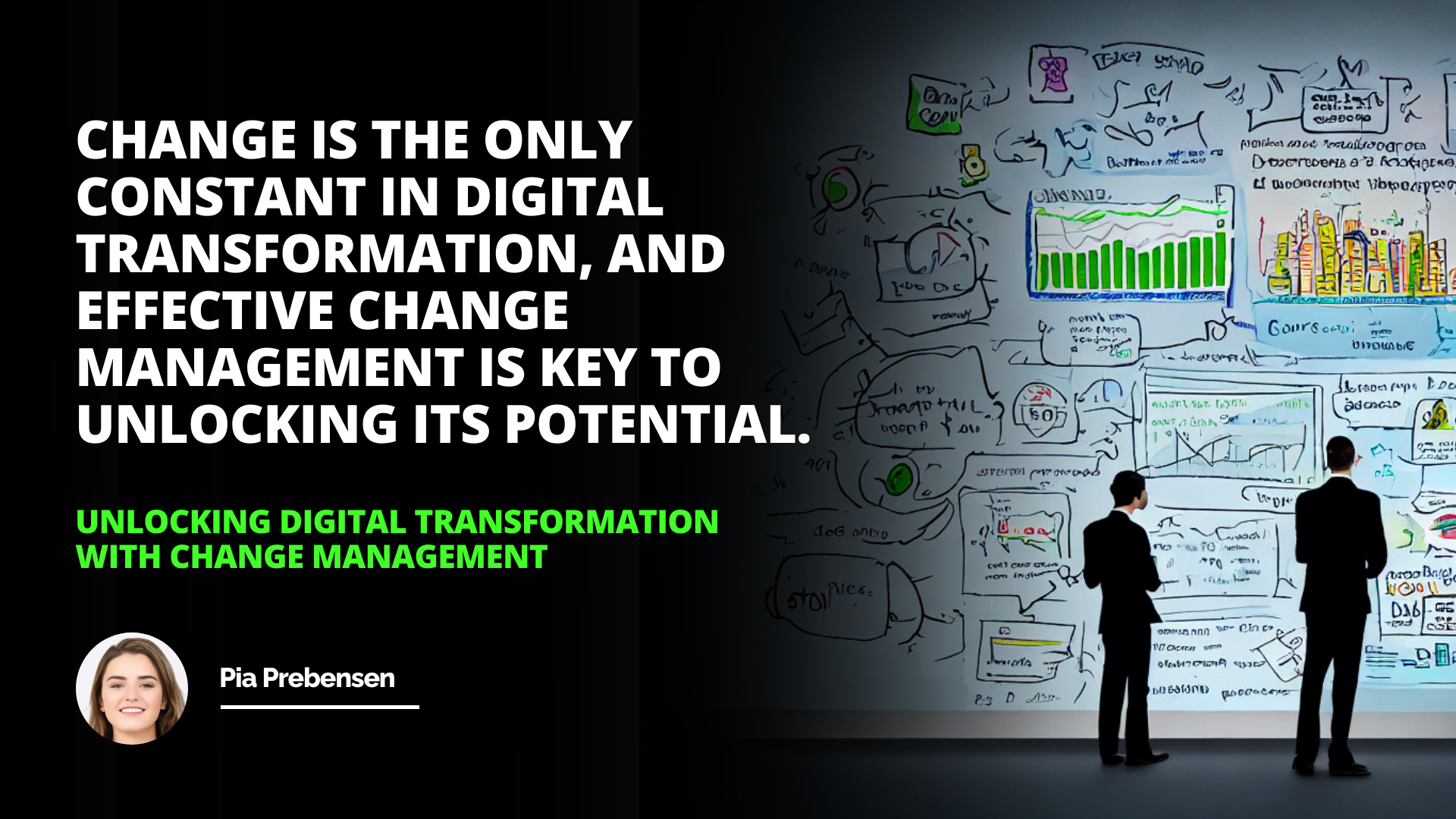
What is Digital Transformation?
The Role of Change Management in Digital Transformation
Benefits of Change Management in Digital Transformation
Challenges of Implementing Change Management in Digital Transformation
Strategies for Successful Change Management in Digital Transformation
Digital transformation has become unavoidable for organizations looking to remain competitive in a rapidly changing digital economy. The promise of digital transformation lies in its ability to unlock new levels of innovation, efficiency, and customer satisfaction. However, to achieve these objectives, organizations must be able to manage change effectively. As a result, change management is driving new digital initiatives' introduction, implementation, and adoption. In this blog, we'll explore the role of change management in digital transformation, the benefits of change management in digital transformation, the challenges of implementing change management in digital transformation, and strategies for successful change management in digital transformation.
What is Digital Transformation?
The digital transformation uses technology to create new or modify existing business processes, cultures, and customer experiences to meet changing business and market requirements. As a result, digital transformation can help organizations become more agile, efficient, and customer-centric. In addition, it can also help organizations take advantage of new opportunities, such as new markets, products, and customer segments.
The Role of Change Management in Digital Transformation
Change management manages to introduce, implement, and adopt new digital initiatives. Change management is essential to digital transformation because it helps organizations anticipate, prepare for, and manage the changes that come with these new digital initiatives. In addition, change management helps organizations manage the people side of digital transformation and ensure their employees are ready, willing, and able to adopt new digital initiatives.
Benefits of Change Management in Digital Transformation
The benefits of change management in digital transformation are significant. First, change management can help organizations successfully implement new digital initiatives by ensuring that employees are ready, willing, and able to make the necessary changes. Change management can also help organizations ensure that the proposed changes are accepted and adopted by employees.
Change management can also help organizations navigate the complexities of digital transformation. Change management can help organizations anticipate potential obstacles and develop strategies to overcome them. Additionally, change management can help organizations identify and address potential risks associated with digital transformation.
Unlocking Success in Organizational Change Management: A Comprehensive Guide
Mastering Control Charts for Change Management: Benefits, Types, Examples & More
The Power of Learning Organizations in Driving Change Management Success
Challenges of Implementing Change Management in Digital Transformation
Despite the many benefits of change management, there are challenges associated with implementing change management in digital transformation. One of the most significant challenges is that change management can be time-consuming and costly. Additionally, change management can be challenging to implement in organizations resistant to change.
Another challenge of implementing change management in digital transformation requires a deep understanding of the organization and its people. Change management requires anticipating and addressing the organization's and its people's needs. Additionally, change management requires developing and implementing strategies tailored to the organization's culture and goals.
Strategies for Successful Change Management in Digital Transformation
Organizations must develop and implement strategies tailored to their needs to ensure successful change management in digital transformation. Organizations should start by assessing their current change management practices and identifying improvement areas. Organizations should also consider developing a comprehensive change management strategy with a clear plan for introducing, implementing, and adopting new digital initiatives.
Organizations should also ensure their change management process is well-communicated to all stakeholders. Communication is critical to successful change management. It helps ensure that all stakeholders know the changes and how they will be affected. Organizations should also ensure they have the right resources to support the change management process. This includes having the right people and tools to manage the change process effectively.
Finally, organizations should develop a process for evaluating the success of their change management efforts. This includes measuring the effectiveness of the change management process and identifying areas where improvements can be made. Assessing the success of change management efforts will ensure that organizations can effectively manage the changes associated with digital transformation and maximize the benefits of digital transformation.
In conclusion, change management is an essential part of digital transformation. Change management helps organizations manage the people side of digital transformation and ensure their employees are ready, willing, and able to adopt new digital initiatives. Change management can also help organizations anticipate potential obstacles and develop strategies to overcome them.
Organizations must develop and implement strategies tailored to their needs to ensure successful change management. Additionally, organizations should ensure that they have the right resources to support the change management process and evaluate the success of their change management efforts. By following these strategies, organizations can ensure that they can effectively manage the changes associated with digital transformation and maximize the benefits of digital transformation.
Change is the only constant in digital transformation, and effective change management is critical to unlocking its potential.
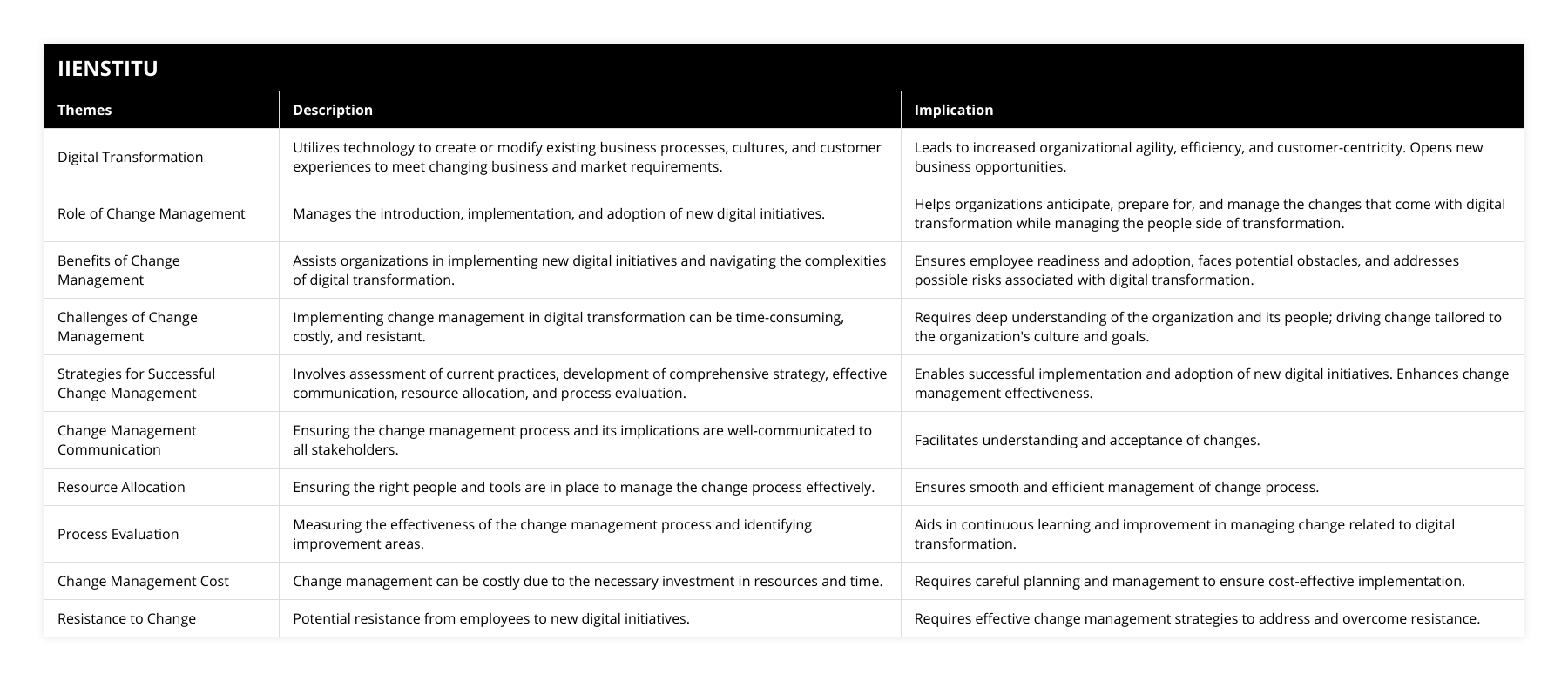
Frequently Asked Questions
What is Digital Transformation?
Digital transformation is an ongoing process of using digital technologies to transform services, experiences, and business models to meet changing market requirements. It uses digital tools, such as cloud computing, data analytics, mobile applications, and artificial intelligence (AI), to create new business opportunities.
Digital transformation enables organizations to leverage technology to create innovative products and services to help them stay competitive in today's highly competitive market. It also helps organizations become more efficient and effective by eliminating manual labor and streamlining processes. This increased efficiency can lead to cost savings and improved customer experience.
In addition, digital transformation helps organizations improve customer satisfaction by providing personalized experiences tailored to individual customers' needs. For example, AI-powered chatbots can provide customers with automated responses tailored to their inquiries or comments. AI-based predictive analytics can also help companies anticipate customer needs before they occur to give an appropriate answer or product when needed.
Furthermore, digital transformation allows businesses to easily access a wide range of data from different sources, such as social media posts and web searches, to gain insights into consumer behaviors or trends that could be used for marketing or product development. Additionally, it allows companies to automate specific tasks, such as inventory management, leading to improved organizational efficiency.
Overall, digital transformation is a powerful tool that allows businesses of all sizes across various industries to benefit from its advantages, including cost savings, improved customer satisfaction, and enhanced efficiency. However, for companies to remain competitive in today's market, they must stay up-to-date on the latest technologies and trends to take full advantage of this technology's capabilities.
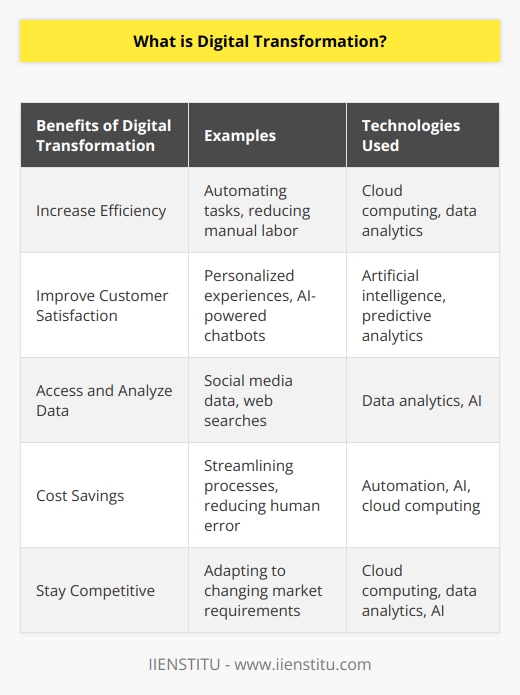
What is the role of Change Management in Digital Transformation?
Digital transformation has become an integral part of businesses in the 21st century. It uses digital technologies to create new or modify existing business processes, cultures, and customer experiences to meet the changing needs of the market and customers. However, while digital transformation is a necessary process, it has challenges. Therefore, change management is an integral part of digital transformation and is essential for its successful implementation.
Change management is a structured approach to transitioning individuals, teams, and organizations from a current state to a desired future state. It is used to manage the people side of change, which includes developing and implementing strategies to manage resistance to change, helping employees understand and accept the need for change, and providing tools and resources to support them in the transition.
In digital transformation, change management is vital in helping organizations move from existing systems and processes to new ones. It helps ensure that employees are adequately prepared for the transition and adapt to the changes. It also helps to ensure that the changes are implemented to minimize disruption and maximize the benefits of digital transformation.
Change management is vital in developing and maintaining a continuous improvement and innovation culture. As digital transformation involves introducing new technologies and processes, it is essential to ensure that they are appropriately integrated into the organization. In addition, change management helps employees engage and enable them to use the latest technologies and techniques to their full potential.
Finally, change management helps to ensure that the digital transformation is sustainable. It helps to ensure that the changes are properly managed and implemented and that the benefits of the digital transformation are realized over the long term.
In conclusion, change management is an integral part of digital transformation and is essential for its successful implementation. It helps to ensure that the transition is smooth and successful and that the benefits of the digital transformation are realized over the long term.
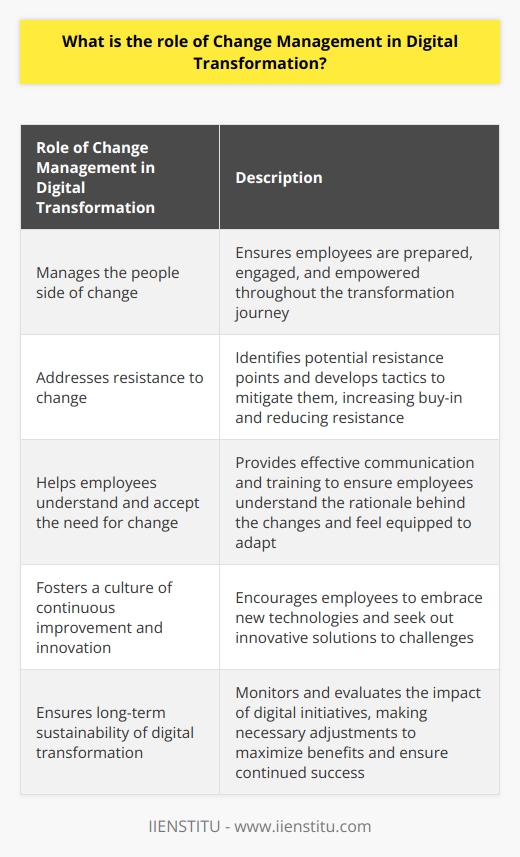
What are the benefits and challenges of implementing Change Management in Digital Transformation?
Digital transformation is a powerful tool for organizations to improve performance, create new opportunities and stay competitive in the modern business landscape. However, as with any significant change initiative, there can be both benefits and challenges associated with its implementation. One of the biggest challenges in digital transformation is incorporating effective change management strategies into the process. Change management ensures smooth transitions and successful outcomes during digital transformation initiatives.
Implementing change management strategies during digital transformation projects has several key benefits. First, change management helps ensure that all stakeholders, from senior leadership to frontline staff, understand and are bought into the implemented changes. This helps to streamline processes, reduce resistance and build consensus amongst teams who may have different opinions about how best to proceed with the project. Additionally, effective change management ensures that employees are adequately trained on new technologies or processes associated with the digital transformation effort. This helps ensure that employees can use these tools fully and reduces the risk of mistakes or errors due to a lack of understanding or knowledge about how they should be appropriately used in practice.
While there are many advantages associated with implementing change management during digital transformations, there can also be specific challenges that must be managed for these initiatives to succeed. One challenge is ensuring a balance between rapidly changing technology and maintaining continuity throughout the process to keep staff and customers manageable by introducing too many changes simultaneously. Additionally, it can be difficult for organizations to identify what changes need to occur to achieve their desired outcomes from a digital transformation initiative - such as improved customer experience or increased efficiency - without introducing too much complexity into their operations or overburdening staff members with too much responsibility at once.
In conclusion, while there are many potential benefits associated with implementing effective change management strategies during a digital transformation initiative - such as improved understanding amongst stakeholders and adequate training of employees on new tools - there are also specific challenges that must be managed carefully for these projects to succeed. Therefore, organizations should ensure they have adequate resources for managing any potential risks associated with implementing rapid technological changes before embarking on any significant digital transformation project if they wish to maximize their chances of achieving successful outcomes from such efforts.
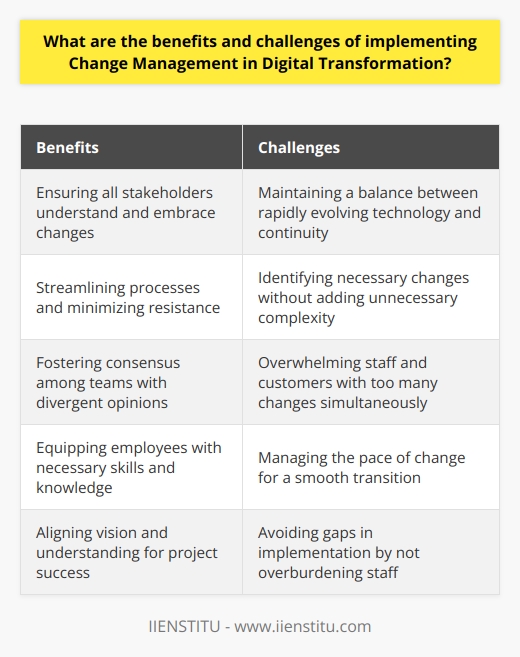
What are the key elements to consider when implementing change management strategies in digital transformation initiatives?
Key Elements in Change Management Strategies
When implementing change management strategies in digital transformation initiatives, it is crucial to consider several key elements. These elements are essential in ensuring smooth integration of new technologies and processes within existing organizational structures.
Effective Communication
Firstly, effective communication plays a pivotal role in change management strategies. It is vital for stakeholders to understand why change is necessary, how it will impact their roles, and the benefits it will bring to the organization. Clear, consistent messaging from leadership helps to build trust and minimize resistance to change.
Inclusive Decision Making
Inclusive decision-making is another critical element in ensuring a successful implementation of change management strategies. By involving key stakeholders such as employees, managers, and external partners in decision-making processes, organizations can foster a sense of ownership and commitment to the changes being made, thereby increasing the chances of successful adoption.
Continuous Learning and Training
In a rapidly changing digital landscape, continuous learning and training are vital for employees to adapt and develop their skills in line with new technologies and processes. Organizations should invest in training programs that enable employees to effectively use new tools and systems, increasing their confidence in the digital transformation initiative.
Performance Metrics and Feedback Mechanism
Organizations must establish performance metrics and feedback mechanisms to monitor the progress of digital transformation efforts. By tracking key indicators of success and gathering input from employees at all levels, leaders can make data-driven decisions and address potential issues early on, ensuring a smoother transition.
Agile Approach to Implementation
Finally, adopting an agile approach to implementation allows organizations to respond rapidly to changes in the digital landscape, making adjustments as needed. By employing iterative processes and being open to continuous improvement, companies can better manage risks and deliver successful digital transformation initiatives.
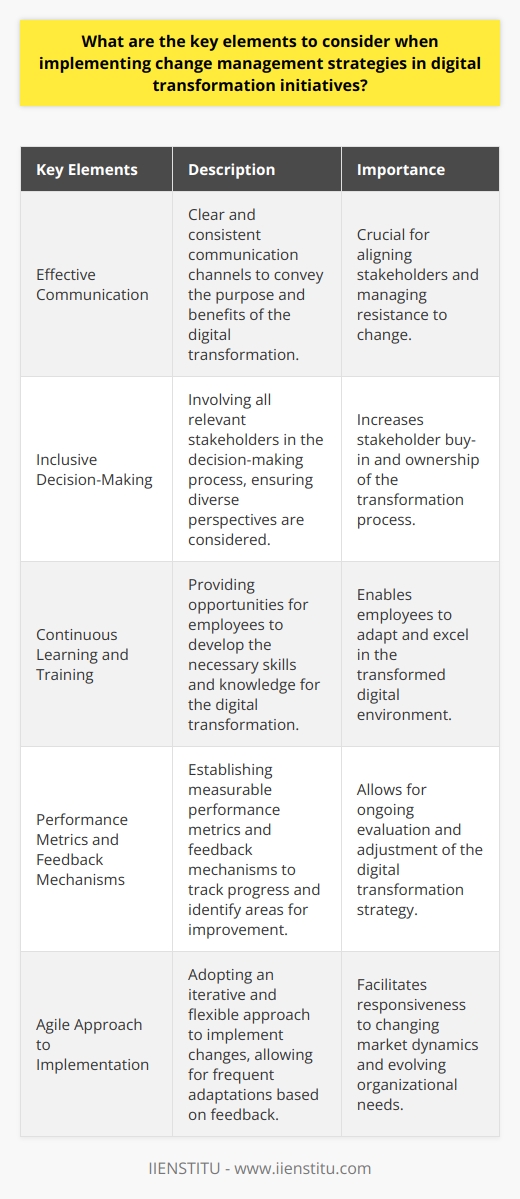
How can organizations successfully navigate the challenges and complexities presented by digital transformation while ensuring effective change management?
Understanding the Digital Landscape
To successfully navigate the challenges and complexities of digital transformation, organizations must first gain a deep understanding of the digital landscape. This includes staying abreast of technological advancements, industry trends, and potential disruptions that could impact their operations. By actively participating in knowledge exchange forums, attending industry conferences, and engaging with experts, organizations can develop a clear vision of the digital environment.
Embedding a Culture of Learning and Adaptability
As digital transformation progresses rapidly, organizations need to foster a culture of continuous learning and adaptability. This can be achieved by offering employees the opportunity to upskill and reskill through training programs, online courses, and knowledge-sharing sessions. Encouraging a growth mindset and embracing a culture of innovation will also contribute to the company's resilience in the face of change.
Creating a Comprehensive Digital Transformation Roadmap
A well-designed roadmap for digital transformation can serve as a valuable tool for organizations to manage change effectively. Such a roadmap should clearly outline the strategic objectives, short-term and long-term milestones, and the necessary resources for implementing the digital initiatives. This roadmap will not only facilitate communication among stakeholders but also enable organizations to measure the progress of their digital transformation journey.
Establishing Cross-functional Communication and Collaboration
To ensure effective change management during digital transformation, organizations must establish strong cross-functional communication and collaboration. This entails breaking down silos and encouraging teams to work together on projects and initiatives. A unified vision and open lines of communication will allow everyone to understand the rationale behind the changes and contribute to their successful implementation.
Empowering Change Agents and Leadership
Lastly, organizations need to empower change agents and leaders who will champion the digital transformation process. These individuals should have a clear understanding of the company's strategic goals, as well as the skills and knowledge necessary to drive change. By equipping these change agents with the right resources, organizations can increase the likelihood of a successful digital transformation journey.
In conclusion, organizations can successfully navigate the challenges and complexities of digital transformation while ensuring effective change management by understanding the digital landscape, embedding a culture of learning and adaptability, creating a comprehensive roadmap, establishing cross-functional communication and collaboration, and empowering change agents and leadership. These interrelated elements will help organizations to adapt and thrive in the rapidly evolving digital world.
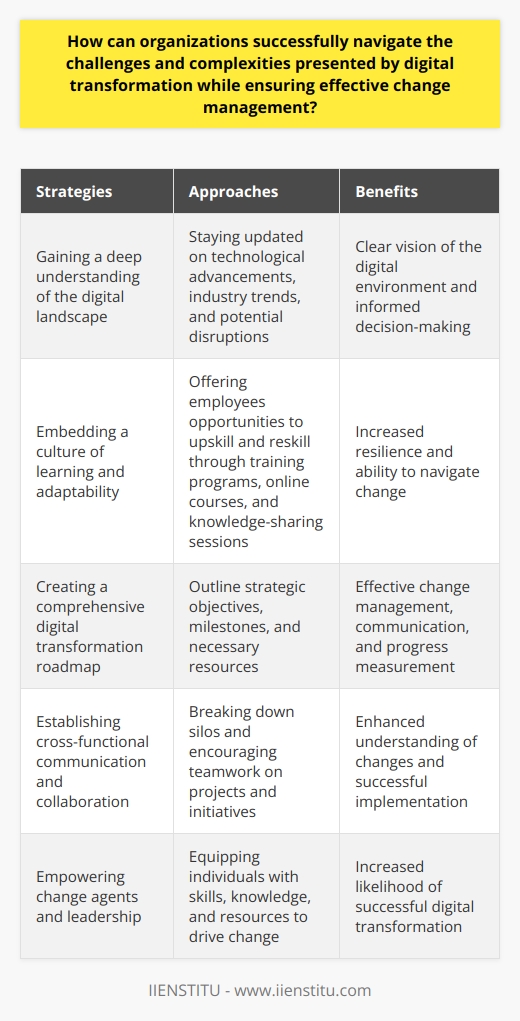
What best practices should be employed by organizations striving for success in the intersection of change management and digital transformation?
Identifying the Intersection
Organizations aiming for success in the intersection of change management and digital transformation should consider employing a variety of best practices. These practices can help lessen the challenges and increase the positive outcomes associated with change management and digital transformation.
Adapting to Digital Shifts
Firstly, in order to thrive in a rapidly evolving digital landscape, businesses must adopt a proactive and agile approach. This involves promoting adaptability by fostering a culture of continuous learning, investing in the upskilling and reskilling of staff, and encouraging experimentation with emerging technologies. By doing so, organizations can better harness the potential of digital tools and maintain a competitive advantage.
Aligning Goals and Strategy
Secondly, successful implementation of digital transformation initiatives necessitates a clear alignment between an organization's strategic goals and its IT strategy. By considering digital transformation as an integral part of the overall business strategy, organizations can ensure that their efforts are geared towards achieving specific and measurable objectives. This alignment will also help maximize the return on investment and achieve long-term sustainability.
Collaborating Across Functions
Additionally, organizations should foster cross-functional collaboration while implementing digital transformation initiatives. By breaking down siloes and encouraging open communication between departments, organizations can promote the exchange of ideas, improve decision-making processes, and ensure that potential challenges are addressed more effectively. Moreover, involving employees from different functions can lead to innovative solutions, as diverse perspectives often result in creative problem-solving.
Emphasizing Human-Centric Design
Another crucial aspect of successful digital transformation is prioritizing a human-centric approach in designing new systems or processes. This entails considering the needs and preferences of end-users and addressing potential resistance to change. By engaging stakeholders in the design and improvement of new digital tools, organizations can enhance user experience, achieve higher adoption rates, and eventually optimize the benefits of digital transformation.
Monitoring Progress and Adjusting
Finally, it is important for organizations to regularly review the progress of their digital transformation initiatives, monitor changing trends and technologies, and be open to making adjustments as needed. This may include revising the business strategy or reallocating resources to other initiatives based on their performance or potential impact. By constantly assessing progress, organizations can ensure that they remain agile and adaptable to market changes, while also optimizing their digital transformation investments.
In summary, organizations striving for success at the intersection of change management and digital transformation should adopt a proactive approach, align their goals and strategy, foster cross-functional collaboration, prioritize human-centric design, and regularly review progress. By following these best practices, organizations can optimize their digital transformation efforts while effectively managing change.
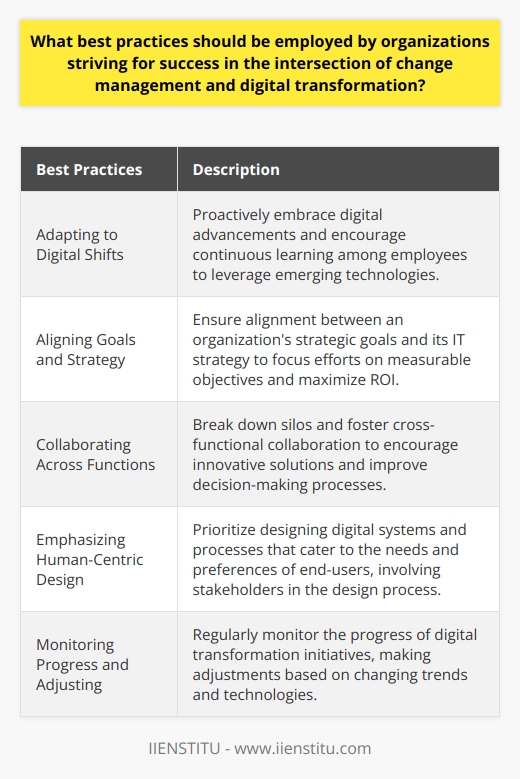
What is the difference between digital transformation and change management?
Understanding Digital Transformation
Digital transformation refers to the integration of digital technologies into all aspects of an organization, fundamentally changing its way of operating and delivering value to its customers. This process is characterized by the application of new technologies, such as cloud computing, artificial intelligence, and data analytics, which enable organizations to streamline their processes, enhance customer experiences, and innovate more rapidly.
Significance of Change Management
On the other hand, change management is a holistic, structured approach to transitioning an organization from its current state to a desired future state. It involves preparing, supporting, and helping individuals, teams, and the organization as a whole adapt to new processes, systems, structures, or cultural shifts. Change management is critical for successful digital transformation efforts, as it ensures that people within the organization are ready and able to embrace new ways of working.
Contrasting the Two Concepts
While both digital transformation and change management are essential for organizational success in the modern business landscape, the primary difference between the two lies in their focus. Digital transformation is centered on the adoption and implementation of new technologies, whereas change management focuses on the people and cultural aspect of the organization. Despite this fundamental difference, it is important to recognize that digital transformation and change management are intricately connected, as technological advancements often trigger the need for significant changes in the way organizations function and how people work.
Achieving Successful Digital Transformation and Change Management
To achieve a successful digital transformation, organizations must prioritize change management to adequately address the human aspect of such initiatives. They must ensure that employees understand the rationale behind the adoption of new technologies, are able to adapt to new processes, and are provided with the necessary training and support. In this way, digital transformation and change management go hand-in-hand.
In conclusion, digital transformation refers to the incorporation of digital technologies that transform an organization's operations and customer service, while change management pertains to the preparedness and support given to employees in adapting to these transformations. When implementing digital transformation initiatives, organizations must emphasize change management to ensure the effective adoption of new technologies and the cultivation of a digital-first mindset among their workforce.
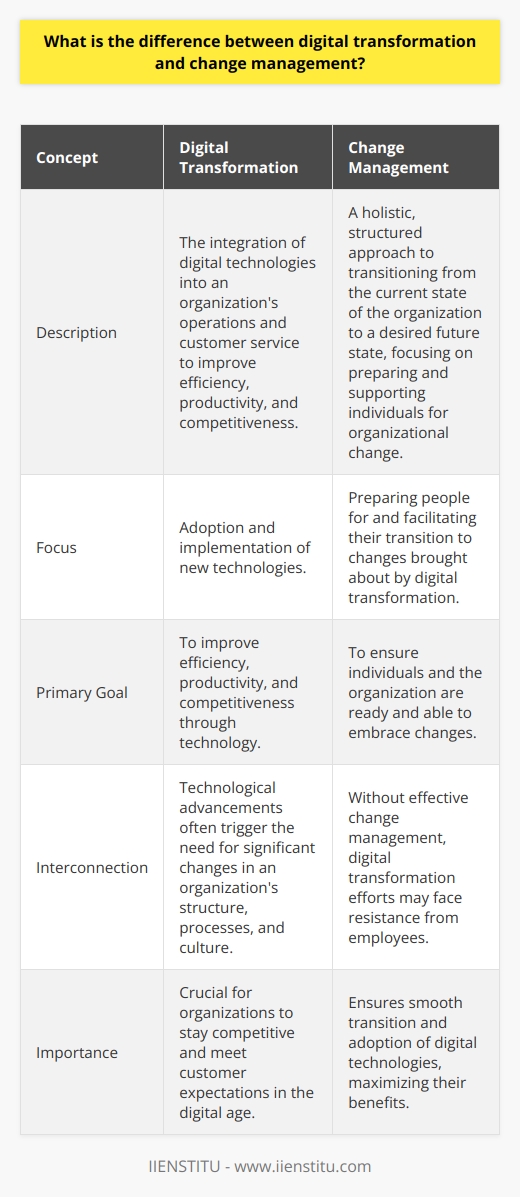
What are the 4 main areas of digital transformation?
Digital transformation is a process that encompasses various domains, aimed at improving business productivity and effectiveness through technological integration. The four main areas of digital transformation are: customer experience, operational efficiency, innovation, and culture and leadership.
**Customer Experience**
The first area, customer experience, focuses on enhancing how customers interact and engage with a business. To stay competitive, businesses must adopt digital tools and technologies to improve their customer journey by providing personalized experiences, adopting omnichannel strategies, and leveraging data-driven insights to anticipate and address customer needs proactively.
**Operational Efficiency**
The second area, operational efficiency, aims at optimizing a company's internal processes and operations through digital technologies. Automation of repetitive tasks, integration of software systems for seamless information flow, and adoption of data analytics tools for informed decision-making are some examples of digital initiatives that streamline business operations and reduce costs.
**Innovation**
The third area, innovation, is marked by the adoption of new digital solutions that transform existing business models, products, or services. Businesses embracing digital transformation look for opportunities to enter new markets, create new revenue streams, and leverage advanced technologies such as artificial intelligence, machine learning, big data, and IoT.
**Culture and Leadership**
Finally, the fourth area of digital transformation, culture and leadership, emphasizes the need for a strong cultural shift and effective leadership to support digital initiatives. Businesses must develop digital-ready skill sets among employees, foster a culture of agility and adaptability, and ensure leadership fully embraces the digital mindset to lead teams through the transformation process effectively.
In conclusion, focusing on customer experience, operational efficiency, innovation, and culture and leadership allows businesses to successfully implement digital transformation strategies. With a comprehensive approach, companies can remain competitive in the evolving digital landscape and unlock new opportunities for growth and success.
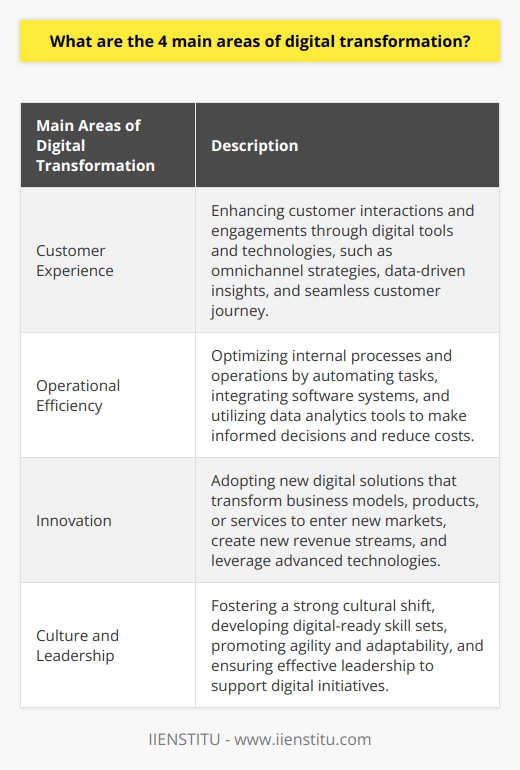
What are the 3 change management strategies to lead transformation?
Change Management Strategies
To effectively lead transformation in organizations, three change management strategies have been identified as crucial. These strategies are designed to ease the transition in organizations, create a supportive environment, and ultimately, ensure success during and after the transformation process. They include clear communication, stakeholder involvement, and monitoring the progress and impact of the changes.
Clear Communication
Communication plays a significant role in managing the transition through the entire organization. By articulating the rationale, objectives, process, and benefits of the transformation, leaders can provide clarity and alleviate concerns among employees. This should include continuous updates on the progress and adjustments made in response to emerging challenges. Open communication channels encourage employees to provide feedback, fostering collaborative problem-solving and promoting buy-in from all levels of the organization.
Stakeholder Involvement
Another critical change management strategy is involving stakeholders in the transformation process. This includes employees, managers, shareholders, and even customers who may be affected by the changes. Stakeholder involvement ensures that diverse perspectives are considered and that the proposed initiatives have the buy-in necessary for them to be successful. Providing opportunities for stakeholder input and participation can increase their commitment to the change and facilitate a smoother transition.
Monitoring Progress and Impact
Lastly, monitoring the progress and impact of the changes is essential to assess the effectiveness of the transformation, make necessary adjustments, or identify areas that require further intervention. By setting benchmarks and KPIs related to the transformation, leaders can evaluate the progress and make data-driven decisions that ensure the organization meets its objectives. This continuous process of evaluation and adjustment helps ensure the long-term success of the change initiative.
In conclusion, clear communication, stakeholder involvement, and monitoring the progress and impact of the changes are three change management strategies that leaders should employ to successfully guide their organizations through transformations. By incorporating these strategies, organizations can navigate the challenges of change effectively and emerge from the transformation process stronger and better equipped for future success.



